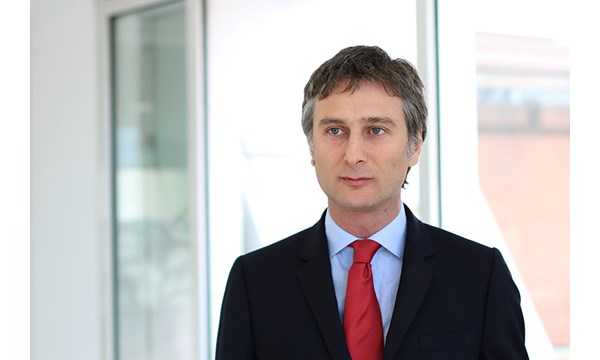Sign up today to get the best of our expert insight in your inbox.
Can emissions taxes decarbonise the LNG industry?
Europe leads the charge
3 minute read
Simon Flowers
Chairman, Chief Analyst and author of The Edge

Simon Flowers
Chairman, Chief Analyst and author of The Edge
Simon is our Chief Analyst; he provides thought leadership on the trends and innovations shaping the energy industry.
Latest articles by Simon
-
The Edge
A world first: shipping carbon exports for storage
-
The Edge
WoodMac’s Gas, LNG and the Future of Energy conference: five key themes
-
The Edge
Nigeria’s bold strategy to double oil production
-
The Edge
US tariffs – unpredictability is the strategic planners’ nightmare
-
The Edge
US upstream gas sector poised to gain from higher Henry Hub prices
-
The Edge
What comes after the Permian for IOCs?
Gavin Thompson
Vice Chairman, Energy – Europe, Middle East & Africa

Gavin Thompson
Vice Chairman, Energy – Europe, Middle East & Africa
Gavin oversees our Europe, Middle East and Africa research.
Latest articles by Gavin
-
The Edge
A world first: shipping carbon exports for storage
-
The Edge
WoodMac’s Gas, LNG and the Future of Energy conference: five key themes
-
The Edge
Nigeria’s bold strategy to double oil production
-
The Edge
US tariffs – unpredictability is the strategic planners’ nightmare
-
The Edge
Upside pressure mounts on US gas prices
-
The Edge
The coming geothermal age
Massimo Di Odoardo
Vice President, Gas and LNG Research

Massimo Di Odoardo
Vice President, Gas and LNG Research
Massimo brings extensive knowledge of the entire gas industry value chain to his role leading gas and LNG consulting.
Latest articles by Massimo
-
Opinion
The impact of the Israel-Iran conflict escalation on the global energy market
-
Opinion
Gas, LNG & The Future of Energy: investment momentum builds in a volatile market
-
The Edge
WoodMac’s Gas, LNG and the Future of Energy conference: five key themes
-
The Edge
Upside pressure mounts on US gas prices
-
Opinion
Video | Lens Gas & LNG: Will Russian gas and LNG come back?
-
The Edge
What a future Ukraine peace deal means for energy (part 1)
The LNG industry is under no illusions about the scale of its carbon challenge. LNG projects are among the most emission-intensive energy assets globally and face growing pressure to decarbonise.
This won’t come cheap. All available options to cut emissions push up the cost of delivered LNG. And after two years of gas market chaos, few buyers today are queuing up to pay a premium for lower-emission LNG.
Carbon taxes could change everything. Europe is already on the case, with the EU extending its emission trading scheme to include shipping from this year. For the first time, LNG vessels arriving in Europe will be subject to a carbon tax on their fuel emissions.
One swallow doesn’t make a summer, as the proverb goes. But could a modest extension of EU carbon policy be the first step on a journey towards meaningful taxes on LNG emissions? Based on our latest Horizons, Massimo Di-Odoardo, Vice President, Gas & LNG, and Gavin Thompson, Vice Chair, EMEA, consider four potential emissions tax scenarios and their impact on trade flows, prices and investment across the LNG value chain.
First, the impact of an EU tax on methane. The EU has agreed to limit methane emissions on its fossil-fuel imports, albeit only for new LNG contracts. With this legislation still at the draft stage, the spectre of a methane tax across all European LNG imports looms large.
Should the EU stop at methane, we expect a modest increase in European gas prices due to methane’s limited share of overall emissions. With LNG emissions varying across projects and regions, though, US LNG projects would likely feel the pinch with their higher levels of methane intensity. Given the relatively low cost of addressing methane losses, an EU methane tax would nudge these projects to reduce these emissions as they target higher European prices.
Second, a future EU decision to move beyond methane and impose a wider import tax on all LNG emissions would have a more material impact. Assuming a carbon tax of US$100/t of CO₂e, European prices would rise by around 18%, elevating Europe to a premium compared to LNG prices in markets without taxes. But with EU LNG demand declining over time, marginal cargoes from the US would not be required through the long term, reducing the European premium.
Elevated prices in Europe could incentivise pre-FID projects to consider more radical decarbonisation. For existing projects, however, this level of tax would be insufficient to drive investment. A more likely outcome would be suppliers and traders leveraging an increasingly liquid global market to sell to Asian buyers attracted to competitive deals, with higher-carbon projects priced out of Europe.
Third, extending taxes of US$100/tonne of CO₂e to the mature markets of Japan and South Korea would lift prices in these markets and re-establish their traditional price premium over Europe. Lower-carbon LNG is again the beneficiary, although some US supply is still required to meet demand. Much like Europe, Northeast Asian prices would reflect the full burden of the emissions tax cost on US LNG imports.
Pre-FID projects close to premium markets will be incentivised to invest in abatement to target higher European and Northeast Asian prices, including reservoir carbon capture and storage of upstream CO₂ emissions and electric drives in LNG plants. But emissions taxes limited to Europe, Japan and South Korea alone would be insufficient to motivate existing LNG projects to reduce all carbon emissions.
Fourth, we have considered the impact a material global tax on LNG emissions would have on the market. Given the cost to decarbonise LNG, the harsh reality is that only a carbon tax approaching US$200/tonne of CO₂e across Europe and all of Asia would provide sufficient economic incentive to push post-FID LNG projects to invest in more costly abatement options.
Though this scenario still appears years away, it shows what’s needed to persuade LNG suppliers to invest the sizeable amounts of capital needed to reduce emissions. Without this, a tax imposed only in a few markets can be broadly circumvented by supplying LNG elsewhere.
Nonetheless, carbon taxes remain the most efficient way for the LNG industry to reduce emissions. As Europe blazes the trail, project operators and developers must respond as LNG’s emission intensity comes home to roost.
Make sure you get The Edge
Every week in The Edge, Simon Flowers curates unique insight into the hottest topics in the energy and natural resources world.









